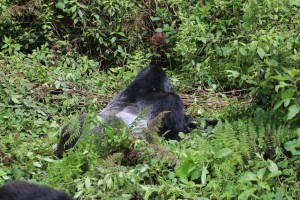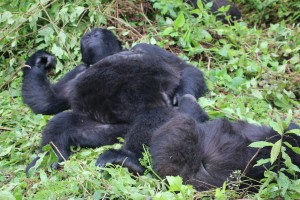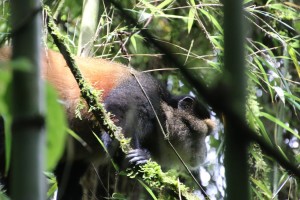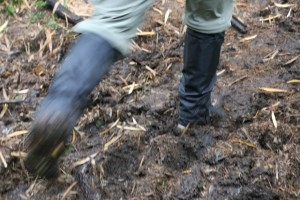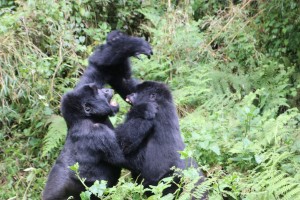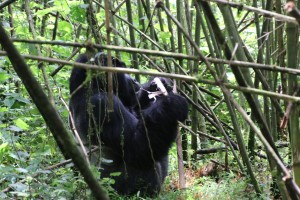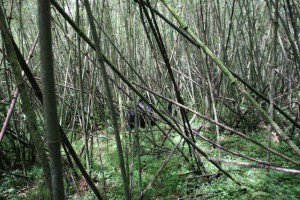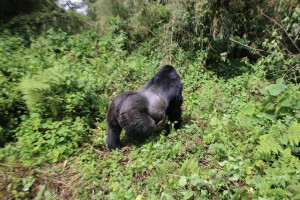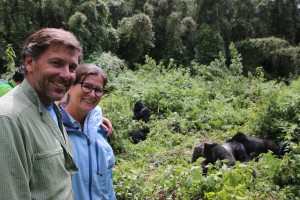The odor is thick. The kind that sticks in your nostrils. Strong musk. Just shy of skunk. I look at our park guide. I can smell them, I say as we move deeper through the bamboo and dense undergrowth. Bosco leads our small group of six. Roger, a second park guide, accompanies us as well as a tracker carrying a machete. The bamboo cracks beneath our feet. We duck under low hanging vines and there, lying flat on their backs, in a small open area not more than 10-12 feet from us are what we have come to see. The Mountain Gorillas — the species brought to the world stage by Dian Fossey almost 50 years ago. The silverback is behind the bush, Bosco says aloud – not in a whisper. A foretelling of the tone of the visit which is about to unfold. I sidestep to the left and the great Agashya comes into view. His long silver back outstretched; his front facing away from me. He is sedate. Chill. Almost as chill as the females sound asleep surrounding him.
Bosco motions for us to follow him further left and deeper into the foliage. Come, black backs are playing here. Black backs are male adults whose backs have not yet grown their silver hair and who are beta to Agashya’s alpha and not permitted to mate. Only Agashya will father the babies of this group.
The word Agashya in the mother tongue of Rwanda, Kinyarwanda, means “special.” Our education about the Mountain Gorillas and this special group started very early that morning.
***
“Good morning!” Lawrence our host at the Bambou Lodge belted out along with a powerful wake-up knock on our rondele door. It’s finally 5:30. I had been awake for who knows how long. I felt nervous about the hike – high altitude and no way to know how far until the trackers found the gorillas. I was also somewhat fearful of being run over by a gorilla. I had felt the power of a baby panda bear when I held one in China. A gorilla’s unleashed, animal strength must be greater.
I jumped out of bed, dressed quickly. My clothes stacked and set aside the night before. I checked on the kids. All ready. Breakfast at six. Innocent, our guide, ready to drive us at 6:30 to the park. Because the minimum age for gorilla trekking is 15, Anna and Layla would be going on the Golden Monkey trek, a species found only in these Virunga Mountains. Trusted Innocent would accompany them every step of the way.
Socala dancers greeted the park visitors at the entrance. The drum beats creating an echo beneath our feet. Caves and hollows had been created under the dirt’s surface by volcanic eruptions in years past. Skies were clear and rain did not appear imminent in this spring season of over 100 inches.
Innocent checked us in with the park rangers while we sipped “Rwanda tea” with about forty other visitors. The maximum number of daily visitors is 80. This was the off-season. Our assignment, gorilla group Agashya. Bosco, introduced himself and Roger, our Parc National Volcans guides. Both were young, perhaps in their late 20’s.
They gathered us together in a circle of concrete benches built into the grassy hillside. He spoke English with ease. We introduced ourselves. Callie and James from Cape Town, South Africa who had joined us for dinner the night before at the lodge; “Lovely people,” the shorthand African-English for kind, smiling, authentic people. They were both in their early 30’s and as nervous and excited to see the gorillas as I was. And John, 57, from Houston, Texas, who was taking a three-month world tour and wishing he had done it ten years earlier.
Bosco held a laminated family tree in his lap. The Agashya group began with two lone females who had moved away from a different group, Bosco began. Many silverbacks had come their way to start a family but the two females fought all of them off – that was until Agashya came along, a handsome, handsome male. Bosco smirks and chuckles. Once the females fully accepted him, he moved in his previous group of females and black backs. Many babies were born but eventually the original two females moved out of the group. Now there were 22 gorillas, one silverback, four black backs, five adult females, unsexed youths, and babies.
Innocent, the girls and Alex and I loaded back into our safari vehicle and drove to where our treks would begin. We turned off the smooth, paved roads “built by the Chinese” that define Rwandan travel and onto a narrow, rocky way to a dead end. The girls hopped out and before we could say goodbye, Innocent had arranged a porter for them and they were off. I threw each a kiss and they disappeared up the path. Alex and I were immediately handed wooden walking sticks, gorilla figures carved at the top, by porters hoping to be hired. The porters are family of former poachers now making their living assisting park visitors. Yes, we hired two. We were off. We first trekked through private farmland and among a species of small eucalyptus trees. Terraced farms pushed right up to the rock wall and sign indicating a narrow entrance into the park. The ground turned muddy and slick. The kind of mud that sucks your boots right off. (I was thankful every step of the way for the used Ahnu boots I bargained for in Arusha.)
Immediately we were in a bamboo forest, tall trees with little undergrowth. In the wet season, the gorillas come down the mountain to eat the fresh shoots. Eating too much makes them a little drunk and upsets their digestion. The gorillas therefore make a “salad” of bamboo shoots and other nutritious plants to maintain a balanced diet and avoid debilitating diarrhea.
We ascended above the forest and into a wide clearing. The peaks of all five volcanoes were visible above a wispy cloud mist. We kept moving, hoping to stay ahead of any rain. A quick hour after entering the park, we met up with the trackers who had located the Agashya group. Here we left our packs and walking sticks before moving in to find our special group.
***
We move away from the silverback and the females, following Bosco into the undergrowth. I duck under low branches and vines and emerge where two black backs, not more than six feet in front of me, are wrestling. I freeze and move closer and a little behind Bosco. One of the trackers speaks in Kinyarwanda from behind us. Bosco turns. Let’s head back to the silverback. He’s mating, he says. You have to be joking!, I think to myself. We turn and retrace our steps. Back in the small clearing, we see Agashya mating a female. So human. I want to look away and give them privacy but here is a once in lifetime chance. The female is facing away and almost impossible to see under the four-hundred pound male. After what feels like a VERY LONG TIME, Agashya comes to his climax and then it appears as if the female does too, vocal and arching up, becoming visible under Agashya’s body. All of us stand frozen and silent. I take a single photo with my phone.
We move back through the brush where the black backs had been wrestling and down a small escarpment toward the creek bed. Three males are wrestling and playing there. We move around and with them as they rumble: Bosco and Roger making low rumbling noises when they come too close. The males romp and then rest. One loudly beats his chest inviting the others to play again. When the play becomes too rough, an adult female nearby runs toward them, raises her voice to warn them that their play has become too violent. The males immediately calm themselves. We now move with our backs toward the small escarpment above the creek bed. All cameras and videos recording the chest beating, wrestling and roiling of the male gorillas. Suddenly the three males’ intertwined, wrestling bodies are hurling down the slope toward us. Callie drops her camera. My phone securely in my hand is now recording the ground, Bosco’s leg, the undergrowth, then my stunned face. Bosco and Roger growl at the males while scooping all of us up and lifting us to grab a hand of the tracker seated on the escarpment behind us. Whew! That was close. You are so lucky, Bosco says. They are “drunk” on the bamboo shoots. And, to see mating. I have seen that rarely.
On the upper tier above the creek bed there is peace. Agashya and the females lounge. One of the smallest babies moves away from her mother a bit, crawling, touching, exploring. Suddenly one of the active black backs pushes by and the baby grabs her mother’s arm. The mother looks up directly at me. I look deeply into the brown soft eyes I have been reading so much about. Her baby’s movements remind me of moments when Layla feels insecure or frightened and wraps her fingers around my arm. I take a deep breath and close my eyes.
A few more minutes, Bosco says. Your hour is almost up. And so are Agashya and the females. It’s lunchtime. They begin to move downhill stopping to eat some shoots along the way, peeling away the outside and chomping the middle. One of the females scoots away holding the shoot in one hand and gathers a different green with the other creating a healthy salad. The group now scurries past us one by one as if saying goodbye. The last clicks of the cameras. Bosco and Roger lead us out to a nearby clearing. The sun is blinding and hot. I stop, look up from the ground where I have been tracking my footing. I look into Alex’s eyes, then James’. Did we just see what we think we saw? Is this real? The porters materialize out of nowhere with our backpacks. We all move out of the sun and sit and rest. I reach into my pack, pull out a brown paper bag. I take one banana for myself then walk to each guide and porter, handing out the rest.
***
More photos in the Gallery, www.AWritersSpace.com/gallery


